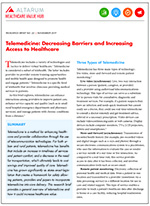Telehealth and Telemedicine
The Health Resources and Services Administration defines telehealth as the use of electronic information and telecommunications technologies to support and promote long-distance clinical healthcare, patient and professional health-related education, public health and health administration.1 The ability to connect providers to patients, in addition to other providers, electronically is particularly important when it comes to expanding access to care.
Two types of telehealth increasingly used in provider shortage areas are electronic consultation and telemedicine. Electronic consultation refers to two-way communications between remote primary care physicians and specialists, while telemedicine connects remote patients to specialists.
Electronic Consultation
Project ECHO is one example of how electronic consultation has been used to increase rural patients' access to specialty care.2 The goal of the program is to "de-monopolize knowledge and amplify local capacity to provide best practice care" by creating virtual communities for providers to share expertise and acquire new skills. Each week, local primary care providers participate in teleconferences with specialists based out of an academic hub. Participants present de-identified patient cases, receive feedback and work with the specialists to establish a plan for treatment.
Project ECHO "clinics" share best practices for more than 55 specialties, including hepatitis C, HIV, substance use disorders, diabetes, autism, pallative care and crisis intervention. Studies show that the model effectively develops subspecialty expertise over time, and that specialty care administered by local providers is as safe and effective as that provided by a specialist.3 Furthermore, the ability to regularly interact with colleagues may increase primary care providers' professional satisfaction, improving retention in rural communities.
Telemedicine
Telemedicine allows patients to electronically access specialists in cases where their healthcare needs cannot be met by local providers. These interactions can include live videoconferencing, "store-andforward" transmission of immages/information and remote patient monitoring. The reported benefits of telemedicine are wide-ranging, including improved access to specialists, increased patient satisfaction and improved health outcomes. A limited number of studies found evidence of cost savings, although increased utilization resulting from expanded access may increase spending on upstream services in an effort to decrease the use of more costly services down the road.
Challenges
Despite its merits, barriers like inadequate reimbursement structures and lack of broadband capability inhibit the widespread adoption of telehealth in rural settings.4 Furthermore, licensure requirements preventing providers from treating patients in states where they are not licensed can undermine the goal of increasing access to specialists, regardless of geographic location. Federal and state efforts to address these barriers include providing funding and technical assistance for rural telehealth programs, investing in infrastructure improvements and joinng the Interstate Medical Licensure Compact, the Enhanced Nurses Licensure Compact, the Physical Therapy Compact and the Psychology Interjurisdictional Compact.
Notes
1. HealthIT.gov, "Telemedicine and Telehealth," (September 28, 2017).
2. University of New Mexico, Project ECHO, "About ECHO: Model."
3. Ibid.
4. Center for Connected Health Policy, "Telehealth Private Payer Laws: Impact and Issues," (August 2017).
- Health Affairs: The Impact Of Telemedicine On Utilization, Spending, And Quality, 2019–22 (April 2024).
- Kaiser Family Foundation: Telemedicine and Pregnancy Care (Feb. 26, 2020).
- FAIR Health: A Multilayered Analysis of Telehealth (July 2019).
- JAMA Internal Medicine: Association Between Broadband Internet Availability and Telemedicine Use (July 29, 2019).
- National Conference of State Legislatures: Increasing Access to Health Care Through Telehealth (May 30, 2019).
- Commonwealth Fund: A Tell-All on Telehealth: Where is Congress Heading Next? (May 16, 2019).
- Healthcare Value Hub: Consumer-Focused Health System Transformation: What are the Policy Priorities? (March 2019).
- Health Affairs: The Current State of Telehealth Evidence: A Rapid Review (December 2018).
- Health Affairs Blog: Giving Urban Health care Access Issues the Attention They Deserve in Telemedicine Reimbursement Policies (Oct. 12, 2017).
- Milbank Memorial Fund: Telehealth Private Payer Laws: Impact and Issues (Aug. 23, 2017).








